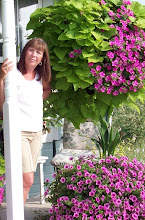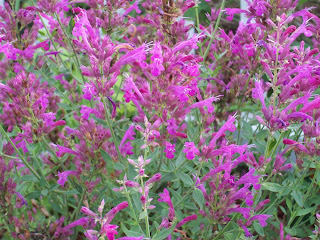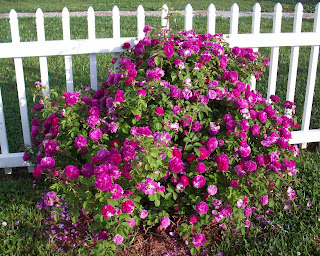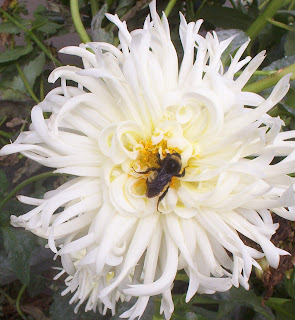I don't know how many times some one has said to me, ". . . you're so lucky you have such a green thumb." Possibly, but I'm not sold on luck. One's ability to have a successful garden isn't in the luck but in the
devotion. My thumb is also dirty from pulling weeds and calloused from dragging the water hose. In my opinion, getting lucky in the garden equates to a growing season of favorable weather conditions.
High Yield Harvest=Commitment
I guess its not surprising then that the question I'm asked most often is: Which varieties produce the greatest yields? I think any gardener will say that's all a matter of opinion. None of my neighbors grow the tomato variety I swear by every season and yet we all have high yield harvests. I think half the joy of vegetable gardening is being able to share opinions. The following is a list of my favorites:
 Pink Girl Tomatoes:
Pink Girl Tomatoes: I've been growing this variety for sixteen years and I've never wanted for lack of tomatoes. They are unusual in that they set both single fruits and fruit clusters. It's nothing to have five to eight tomatoes in one bunch. They can be a bit fussy to get started because they are not cold tolerant at all. But, once they get growing, I've had vines stand at ten feet tall. The fruit itself is sweet and solid with thin skin and less than average seed production. The fruits are usually about 6-8 ounces but I've had some grow to the size of a softball. I like them for both slicing and cooking. They also freeze well.
Roma Italian Green Beans: I quit growing all other types of green beans simply because the Roma's produce twice as many pods as any other bush bean I've sown. Not only are they heavy producers but they also grow twice as large as other green beans without getting tough. The Roma has a flat, smooth pod. From my experience, germination and harvest time is equivalent to other green beans varieties.
Armenian Yard Long Cucumbers: Not only is this cucumber a real producer but it is highly unique in appearance. Growing up to three feet long, it has a ridged outer skin that stays pale green in color. The Armenian seldom gets pithy, consistently producing solid, white flesh that is crisp and mildly flavored.
Semi-dwarf Okra: I don't have a favorite variety within the semi-dwarf line. I grow this type because the plants don't get huge and try taking over the garden. I find that the semi-dwarf produces just as much as the tall Okra varieties. Okra is a prolific producer, requiring daily monitoring because the vegetables grow quickly and become tough.
Jade Cross Brussel Sprouts: I had sixteen of these plants in my garden this season and they produced 8 beautiful gallons of sprouts. This variety holds up well in the heat and humidity of a Midwest summer with adequate amounts of water. The sprouts were well formed and were mild in flavor.
 Danver's Half Long Carrots:
Danver's Half Long Carrots: I only plant one 32 ft row of these to keep us in carrots all winter long. And, they are good keepers. I've had them stay nice and crisp until late winter with proper refrigeration. I plant a row in the spring and other than water, they require little care until I harvest them in the fall.
Danver's has a nice, sweet flavor. The flesh is bright orange and fine grained. These carrots average about 7 1/2" root growth but they can grow almost as long as regular varieties. I think carrots really respond well to raised bed gardening which is the particular type of vegetable gardening I subscribed to. The raised bed allows excess water to drain away so that the carrots don't get bogged down and rot.
Flat Dutchman Cabbage: These cabbages grow more oblong than round but they are dense and solid and resistant to cracking. It's nothing to pull a ten pounder out of the garden when they are ready to harvest. They are probably the best for heat tolerance when getting to the end of their growing season. They have a medium to strong flavor. The Flat Dutchman are great keepers with proper refrigeration.
Watermelon Mantang Hong Radish: An awesome radish for both flavor and presentation. The outside skin is white at the root and green closer to the foliage. When sliced, the rosy red center is revealed. Lovely. The
Watermelon Mantang Hong Radish is a bit slower to germinate and produces after regular radishes but they grow twice the size, some up to 3 1/2" in diameter, while maintaining a sweet flavor. Never hot.
New Zealand Spinach: Another unusual variety, this leafy green must be planted after fear of frost. Unlike other spinach, this grows well all summer. Cutting it backs just promotes more growth. The seed is large and can be soaked in water prior to planting to aid in germination. It has a fairly strong flavor. The leaves are great for raw use in salads but they also hold up great in stir fry.
Early White Vienna Kohlrabi: Superior growth makes this vegetable from the cabbage family a real winner. Unlike it's cabbage cousin, it doesn't seem to be bothered by heat. I planted these at the end of June and they produced just fine. Flavored like a cabbage but textured more like a turnip, the meaty white flesh stays solid and crisp.
Ghost Busters Eggplant: When these little plants start producing, look out. It's nothing to see a dozen white eggs hanging from its branches. These eggplant don't get nearly as large as the regular black beauty eggplant but I think they stay solid longer. I also think they are a better keeper. I can't tell any difference in flavor.
 Yellow Crookneck Summer Squash:
Yellow Crookneck Summer Squash: I think anyone who's ever grown these has a horror story of how out of control they can produce. Great for frying and baking. They also freeze well. I slice them up and put them in freezer bags and use them for Summer Squash Casserole all winter long.
Black Beauty Zucchini: An old time favorite, Black Beauty is great for steaming, stir frying, and baking. This zucchini makes a lovely cake as well. A super producer. It stays solid as it grows large. Unfortunately, the squash bugs love this squash and I'm constantly doing battle with them over this vegetable. It's worth it.
I garden in zone 5. Hopefully, this list will help answer some of those questions asked about varieties and yields I hear so often. Whatever you decide to plant this next season---Happy vegetable gardening!
 I bought this lovely three-tier planter in my early gardening years. The largest basket is at the bottom of the tier with a depth of 5 1/2 inches, the center basket 5 inches and the top basket measures in at a whopping 4 1/2 inches, thus the additon of the coconut liners which add an extra inch or two of depth. Instead of being sited in full sun on my westerly exposed back deck which was my original intention, the lovely three-tier planter resides in the shade of my easterly exposed front porch. Even so, successful growing in these shallow baskets requires daily watering and, depending on the type of planting (supertunia and sweet potato vine), daily feeding.
I bought this lovely three-tier planter in my early gardening years. The largest basket is at the bottom of the tier with a depth of 5 1/2 inches, the center basket 5 inches and the top basket measures in at a whopping 4 1/2 inches, thus the additon of the coconut liners which add an extra inch or two of depth. Instead of being sited in full sun on my westerly exposed back deck which was my original intention, the lovely three-tier planter resides in the shade of my easterly exposed front porch. Even so, successful growing in these shallow baskets requires daily watering and, depending on the type of planting (supertunia and sweet potato vine), daily feeding.












 Yellow Crookneck Summer Squash: I think anyone who's ever grown these has a horror story of how out of control they can produce. Great for frying and baking. They also freeze well. I slice them up and put them in freezer bags and use them for Summer Squash Casserole all winter long.
Yellow Crookneck Summer Squash: I think anyone who's ever grown these has a horror story of how out of control they can produce. Great for frying and baking. They also freeze well. I slice them up and put them in freezer bags and use them for Summer Squash Casserole all winter long. 
